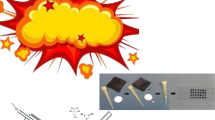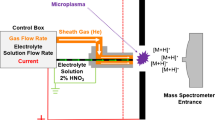Abstract
The different chemical forms of arsenic compounds, including inorganic and organic species, present distinct environmental impacts and toxicities. Desorption electrospray ionization mass spectrometry (DESI-MS) is an excellent technique for in situ analysis, as it operates under atmospheric pressure and room temperature and is conducted with no/minimal sample pretreatment. Aimed at expanding its scope, DESI-MS is applied herein for the quick and reliable detection of inorganic (arsenate—As(V): AsO4 3− and arsenite—As(III): AsO2 −) and organic (dimethylarsinic acid—DMA: (CH3)2AsO(OH) and disodium methyl arsonate hexahydrate: CH3AsO3·2Na·6H2O) arsenic compounds in fern leaves. Operational conditions of DESI-MS were optimized with DMA standard deposited on paper surfaces to improve ionization efficiency and detection limits. Mass spectra data for all arsenic species were acquired in both the positive and negative ion modes. The positive ion mode was shown to be useful in detecting both the organic and inorganic arsenic compounds. The negative ion mode was shown only to be useful in detecting As(V) species. Moreover, MS/MS spectra were recorded to confirm the identity of each arsenic compound by the characteristic fragmentation profiles. Optimized conditions of DESI-MS were applied to the analysis of fern leaves. LC-ICP-MS was employed to confirm the results obtained by DESI-MS and to quantify the arsenic species in fern leaves. The results confirmed the applicability of DESI-MS in detecting arsenic compounds in complex matrices.




Similar content being viewed by others
References
ATSDR Agency for toxic substances and disease registry (2011) Priority List of Hazardous Substances. http://www.atsdr.cdc.gov/SPL/. Accessed 22 April 2012
WHO World Health Organization (2001) Environmental health criteria 224: arsenic and arsenic compounds. Geneva. http://www.inchem.org/documents/ehc/ehc/ehc224.htm. Accessed 22 april 2012.
Vasconcelos O, Palmieri H, Matschullat J, Deschamps E (2007) In: Deschamps E, Matschullat J. Arsênio antropogênico e natural: um estudo em regiões do Quadrilátero Ferrífero. Belo Horizonte: Fundação estadual do meio ambiente.
Ma LQ, Komar KM, Tu C, Zhang W, Cai Y, Kennelley ED (2001) A fern that hyperaccumulates arsenic. Nature 409:579
Barra CM, Santelli RE, Abrão JJ, Monizat M (2000) Especiação de arsênio—uma revisão. Quim Nova 23:58–70
Mir KA, Rutter A, Koch I, Smith P, Reimer KJ, Poland JS (2007) Extraction and speciation of arsenic in plants grown on arsenic contaminated soils. Talanta 72:1507–1518
Nam SH, Oh HJ, Min HS, Lee JH (2010) A study on the extraction and quantification of total arsenic and arsenic species in seafood by HPLC-ICP-MS. Microchem J 95:20–24
Anawar HM (2012) Arsenic speciation in environmental samples by hydride generation and electrothermal atomic absorption spectrometry. Talanta 88:30–42
Garcia-Sartal C, Taebunpakul S, Stokes E, Barciela-Alonso MC, Bermejo-Barrera P, Goenaga-Infante H (2012) Two-dimensional HPLC coupled to ICP-MS and electrospray ionization (ESI)-MS/MS for investigating the bioavailability in vitro of arsenic species from edible seaweed. Anal Bioanal Chem 402:3359–3369
Llorente-Mirandes T, Ruiz-Chancho MJ, Barbero M, Rubio R, Lopez-Sanchez JF (2011) Determination of water-soluble arsenic compounds in commercial edible seaweed by LC-ICP-MS. J Agric Food Chem 59:12963–12968
Chen HW, Hu B, Zhang X (2010) Principle and application of ambient mass spectrometry for direct analysis of complex samples. Chin J Anal Chem 38:1069–1088
Takáts Z, Wiseman JM, Gologan B, Cooks RG (2004) Mass spectrometry sampling under ambient conditions with desorption electrospray ionization. Science 306:471–473
Laskin J, Heath BS, Roach PJ, Cazares L, Semmes OJ (2012) Tissue imaging using nanospray desorption electrospray ionization mass spectrometry. Anal Chem 84:141–148
Gerbig S, Golf O, Balog J, Denes J, Baranyai Z, Zarand A, Raso E, Timar J, Takats Z (2012) Analysis of colorectal adenocarcinoma tissue by desorption electrospray ionization mass spectrometric imaging. Anal Bioanal Chem 403:2315–2325
Nielen MWF, Hooijerink H, Zomer P, Mol JGJ (2011) Desorption electrospray ionization mass spectrometry in the analysis of chemical food contaminants in food. TrAC Trend Anal Chem 30:165–180
Thunig J, Flo L, Pedersen-Bjergaard S, Hansen SH, Janfelt C (2012) Liquid-phase microextraction and desorption electrospray ionization mass spectrometry for identification and quantification of basic drugs in human urine. Rapid Commun Mass Spectrom 26:133–140
Fabrizi G, Fioretti M, Rocca LM, Curini R (2012) DESI-MS2: a rapid and innovative method for trace analysis of six cytostatic drugs in health care setting. Anal Bioanal Chem 403:973–983
Campbell IS, Ton AT, Mulligan CC (2011) Direct detection of pharmaceuticals and personal care products from aqueous samples with thermally-assisted desorption electrospray ionization mass spectrometry. J Am Soc Mass Spectrom 22:1285–1293
Morelato M, Beavis A, Ogle A, Doble P, Kirkbride P, Roux C (2012) Screening of gunshot residues using desorption electrospray ionization-mass spectrometry (DESI-MS). Forensic Sci Int 217:101–106
Kennedy JH, Wiseman JM (2010) Direct analysis of Salvia divinorum leaves for salvinorin A by thin layer chromatography and desorption electrospray ionization multi-stage tandem mass spectrometry. Rapid Commun Mass Spectrom 24:1305–1311
Li B, Bjarnholt N, Hansen SH, Janfelt C (2011) Characterization of barley leaf tissue using direct and indirect desorption electrospray ionization imaging mass spectrometry. J Mass Spectrom 1241–1246
Müller T, Oradu S, Ifa DF, Cooks RG, Kräutler B (2011) Direct plant tissue analysis and imprint imaging by desorption electrospray ionization mass spectrometry. Anal Chem 83:5754–5761
Lin Z, Zhao M, Zhang S, Yang C, Zhang X (2010) In situ speciation on solid surfaces by desorption electrospray ionization tandem mass spectrometry. Analyst 135:1268–1275
Takáts Z, Wiseman JM, Cooks RG (2005) Ambient mass spectrometry using desorption electrospray ionization (DESI): instrumentation, mechanisms and applications in forensics, chemistry, and biology. J Mass Spectrom 40:1261–1275
Talaty N, Takáts Z, Cooks RG (2005) Rapid in situ detection of alkaloids in plant tissue under ambient conditions using desorption electrospray ionization. Analyst 130:1624–1633
Florêncio MH, Duarte MF, Bettencourt AMM, Gomes ML, Vilas Boas LF (1997) Electrospray mass spectra of arsenic compounds. Rapid Commun Mass Spectrom 11:469–473
Moreira CM, Duarte FA, Lebherz J, Pozebon D, Flores EMM, Dressler VL (2011) Arsenic speciation in white wine by LC-ICP-MS. Food Chem 126:1406–1411
Zhao FJ, Wang JR, Barker JHA, Schat H, Bleeker PM, McGrath SP (2003) The role of phytochelatins in arsenic tolerance in the hyperaccumulator Pteris vittata. New Phytol 159:403–410
Tu S, Ma LQ, Luongo T (2004) Root exudates and arsenic accumulation in arsenic hyperaccumulating Pteris vittata and non-hyperaccumulating Nephrolepis exaltata. Plant Soil 258:9–19
Acknowledgments
The authors are grateful to the Brazilian funding agencies Coordenação de Aperfeiçoamento de Pessoal de Nível Superior (CAPES), Conselho Nacional de Desenvolvimento Científico e Tecnológico (CNPq) and Fundação de Amparo à Pesquisa do Estado de Minas Gerais (FAPEMIG–CEX–PPM-00433-10) for their financial support.
Author information
Authors and Affiliations
Corresponding author
Additional information
Published in the topical collection (Bio)Analytical Research in Latin America with guest editors Marco A. Zezzi Arruda and Lauro Kubota.
Rights and permissions
About this article
Cite this article
de Abreu, L.B., Augusti, R., Schmidt, L. et al. Desorption electrospray ionization mass spectrometry (DESI-MS) applied to the speciation of arsenic compounds from fern leaves. Anal Bioanal Chem 405, 7643–7651 (2013). https://doi.org/10.1007/s00216-013-6986-y
Received:
Revised:
Accepted:
Published:
Issue Date:
DOI: https://doi.org/10.1007/s00216-013-6986-y




